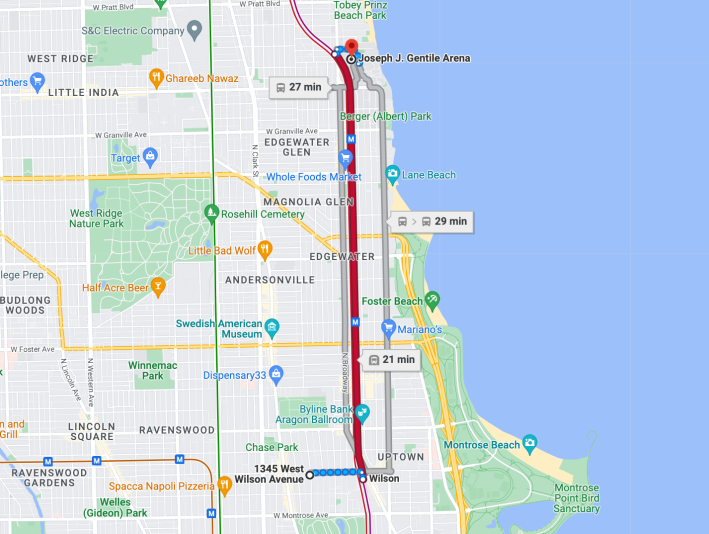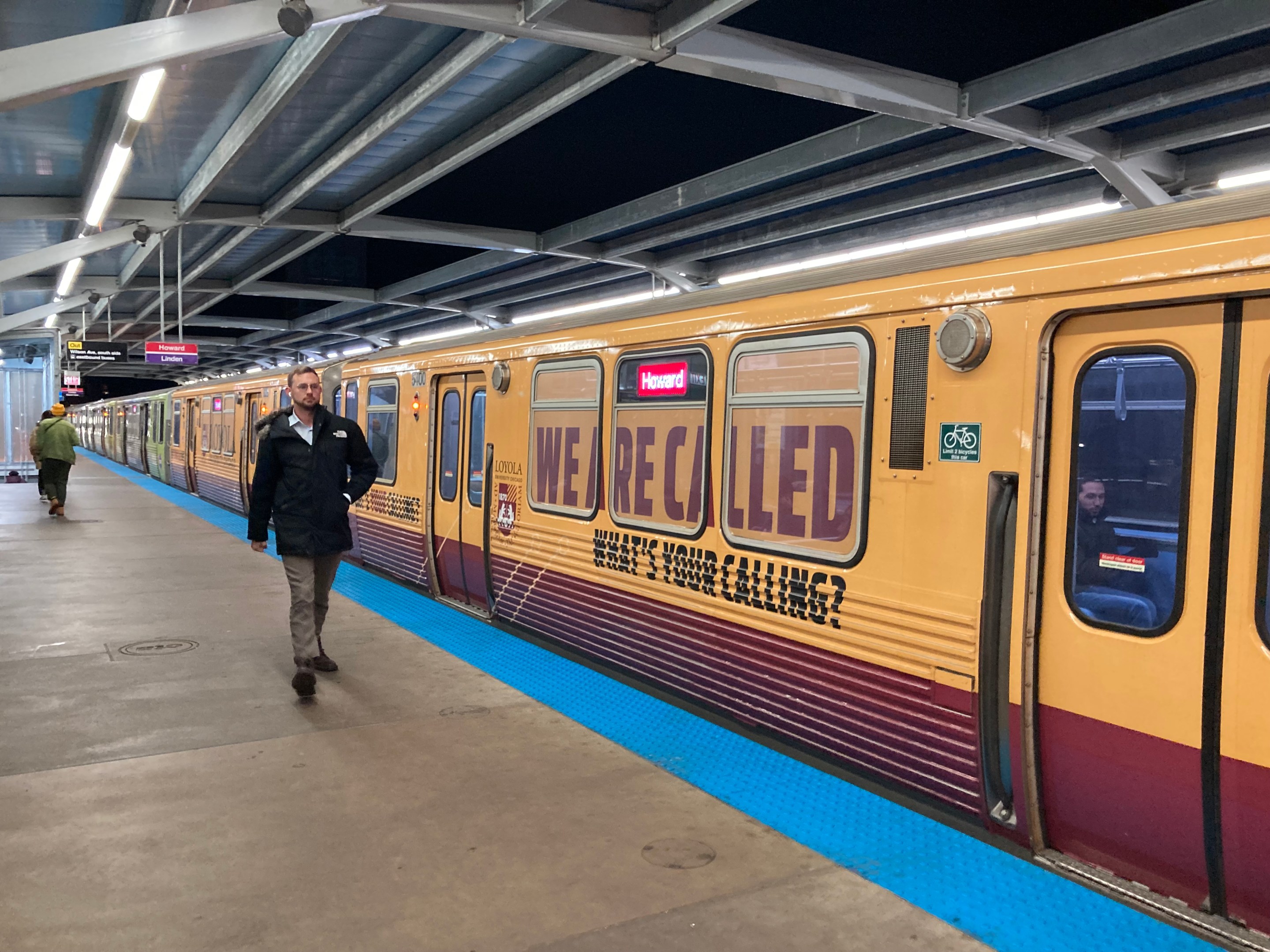Last Wednesday night around 10 p.m. I was leaving Loyola University Chicago's basketball arena in Rogers Park with a couple of friends, after watching the Ramblers defeat the University of Central Arkansas Bears. We were heading back to our homes in and near Uptown. I had bicycled to the game, but my companions had taken the CTA Red Line. The weather was bitterly cold for this time of year.
We were traveling home together, and my assumption was that we would simply walk west across Sheridan Road to catch the 'L' at the Loyola Red station. But my friends immediately pulled out their smartphones and looked at transit apps, trying to figure out the most efficient possible way to get home.

They saw that a southbound #36 Broadway bus was approaching Devon Street and Sheridan in a few minutes that could take us to the Wilson station in Uptown, whereas the next inbound Red Line train wasn't scheduled to arrive for several more minutes. (Side note: It's nice to live in a city where there are often multiple transit options to get where you need to go, aka a "belt and suspenders" situation.)
So they saw it as a dilemma. Should we hustle to catch the bus, which would leave sooner but travel slower, or take our time catching the train, the speedier option? (CTA buses and trains both accommodate bikes, although bicycles are prohibited on the 'L' during rush hours, so I'd be able to take my cruiser with me either way.)
My feeling was that they were overthinking the matter. The station was right there, we weren't in any particular hurry, and a train would show up sooner or later, so why bother to look at apps or rush to a bus stop? Ultimately we went to the Loyola station, and our train arrived after only a few minutes, sooner than predicted.

This episode got me thinking about different styles of riding the CTA. I totally think it makes sense to look up public transportation directions on Google Maps, or the Ventra or Transit apps if you're making an unfamiliar journey. Certainly, you want to make sure the train or bus you plan to catch is running that time of day.
For example, I live near Montrose Avenue in Uptown, so if I'm coming back from O'Hare at night, I might take the Blue Line to the Montrose station and then catch the 78 Montrose bus east. However, it's important to know the Montrose bus stops running around 10 p.m., so if I'm traveling later at night I need to instead get off the train at the Jefferson Park Transit Center and catch the 81 Lawrence bus, which runs all night.
And once I'm at a bus stop, I'll often look at the CTA's Bus Tracker website or text the number on the bus stop sign for predicted arrival times, so I'll have a sense of how long I'm be waiting. (According to the CTA, unlike 'L' arrival times, these methods are strictly based on real-time data, not theoretical scheduled arrival times, which means the hated "ghost run" problem – vehicles that appear on tracker or app screens only to disappear before they show up – isn't really an issue.)
But I generally don't bother to look online to try to determine exactly when I should leave for a stop or station to minimize my wait time. And I'm usually not concerned with figuring out precisely which method would supposedly be the most efficient at that particular time of day.
That doesn't mean my approach is the right one, of course. You might interpret my approach as me being a chill, "go with the flow" kind of person. Conversely, you could view me as a lazy luddite.
One reason I might have a different POV on this matter than my friends could be generational. I'm 51 and they're several years younger. I've spent most of my life during a time when catching transit simply involved walking to a stop or station. They've spent a higher percentage of their lives during the smartphone era.
Likewise, Streetsblog Chicago cofounder Steven Vance, a Millennial who has designed urban planning-related applications (most notably the Chicago Burrito Tracker), confirmed he always consults an app before leaving his home to catch the CTA.

And I have to admit, it's pretty cool when my friend and I are about to head to the Wilson station to catch the Red Line, and they pull out the Transit app and see there's an eastbound bus on Wilson a block away from us, so we rush to the bus stop and instantly catch a lift to the station for a totally seamless trip.
On the other hand, the utility of the trackers and apps has been compromised during the COVID-19 pandemic, when labor shortages have meant that many scheduled runs go unstaffed. For example, today the advocacy group Commuters Take Action tweeted that only 68 percent of scheduled Blue Run trains materialized yesterday. That's despite the fact that the CTA recently adjusted its schedules to better reflect the current number of bus and train operators.
So if you're using the Train Tracker and apps that rely on scheduled arrival times as well as GPS data, you may be let down by a ghost run. But if you don't bother to look at theoretical arrival times in advance, you won't be disappointed by overly-optimistic predictions. Of course, you may still have an infuriatingly long wait for the next bus or train due to staffing shortages and other potential snags.
It bears repeating that the most effective strategy for exorcising the transit system of ghosts will be for the CTA to get staffing up to pre-pandemic levels. The agency has been trying to do this by holding multiple job fairs and offering new financial incentives to help retain and recruit workers. If the agency succeeds at that, ghost runs should become much less of an issue.
Yesterday I surveyed my Twitter followers on their transit-riding approach.
What kind of @CTA rider are you?
— John Greenfield (@greenfieldjohn) December 1, 2022
1. I use (often unreliable) Transit Trackers and apps to get predictions of when buses, trains will arrive and plan my trip accordingly, hustling to get to the stop or station on time.
2. I just show up, and figure a run will arrive eventually.
Out of the 124 people who responded within a few hours, 57.3 percent identified as planners, while the remaining 42.7 percent said they were laissez-faire. Here are a few of their comments:
- "I use my tracker app during my trip to figure out what to do (when a transfer is involved) so I’d say I’m a mix. Though I am [a planner] when I have to take Metra or Pace."
- "Planner, but that stems from relying on Metra and Pace more than CTA."
- "Since generally I use [CTA] go to and from an office job, I'm coming and going at the same time, so the train arrives when it arrives. If there's a non-work-related CTA ride, I might get out the tracker, just to see if I need to hustle."
- "I use a tracker for buses, but not so much for trains."
- "Depends on the time of day. During rush hour I know I wont be waiting around for too long, but any time besides that I'm keeping an eye on when the next train comes and timing myself around that."
So where do you stand on the issue – are you a planner or a slacker, I mean laissez-faire rider, like me?




